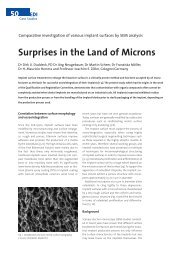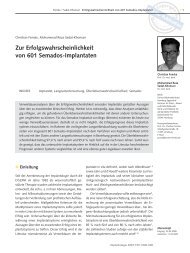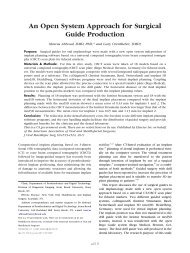implantaten und Aufbau - BEGO
implantaten und Aufbau - BEGO
implantaten und Aufbau - BEGO
Sie wollen auch ein ePaper? Erhöhen Sie die Reichweite Ihrer Titel.
YUMPU macht aus Druck-PDFs automatisch weboptimierte ePaper, die Google liebt.
Originalia – Materials Science<br />
7<br />
In-vitro corrosion current measurement between<br />
titanium implants and superstructures made<br />
of titanium, gold and cobalt chrome alloys<br />
M. Gente, J. Dati, P. Günter, S. Pruss, S. Rickmeyer, S. Vittur<br />
Marburg<br />
When a tooth is lost, the resulting gap can be<br />
closed with a bridge. Although the adjoining<br />
teeth may have no hard tissue defects, or only<br />
minor defects, they will inevitably be damaged<br />
during construction of the bridge. Placement of<br />
an implant is therefore the more favourable solution.<br />
Furthermore, implants can be used in<br />
isolation for tooth replacement, which is why<br />
they are becoming increasingly popular in spite<br />
of their high cost. Nevertheless, account must<br />
be taken of the effect that the implant material<br />
will have on other metals in the mouth as regards<br />
corrosion. In this context, corrosion means<br />
the gradual degradation of a material due<br />
to the influence of other materials in its surro<strong>und</strong>ings.<br />
The implant and the respective metal<br />
superstructures form a galvanic cell. The<br />
aim of this paper is to investigate the corrosion<br />
currents between a titanium implant and various<br />
metallic superstructure materials.<br />
Materials and method<br />
The aim was to investigate the corrosion currents<br />
between an implant (Semados S 3.75 L13<br />
LOT 902621, Bego Implant Systems, Bremen)<br />
and the superstructures made of a cast, highgold<br />
alloy (Degunorm, Degussa Hanau), prefabricated<br />
superstructures made of commercially<br />
pure titanium (Sub-Tec titanium abutment S<br />
5.5, LOT 901728, Bego Implant Systems, Bremen)<br />
and prefabricated CoCrMo superstructures<br />
(Sub-Tec Wirobond ® MI abutment 5.5, LOT<br />
902286, Bego Implant Systems, Bremen). The<br />
compositions of the alloys, as stated by the manufacturers,<br />
are given in Table 1.<br />
As it was not possible to prepare the surface of<br />
the cylindrical superstructures evenly using<br />
abrasive paper, a uniform finish was ensured by<br />
sandblasting all the superstructures with an<br />
abrasive of grit size 110 µm (Korox, <strong>BEGO</strong>, Bremen),<br />
at a pressure of 2 bar, until a matt surface<br />
was produced. The superstructures were then<br />
Corrosion currents were investigated between titanium implants and superstructures<br />
made of various dental metals (CoCrMo alloy Wirobond, grade 4<br />
purity titanium and high-gold alloy Degunorm) when in electrical contact.<br />
The electrolytes used were unbuffered normal saline solution with a pH of 6<br />
and also with a pH of 2.3, created by the addition of lactic acid. The pairing<br />
of titanium implant and cobalt-chrome superstructure displayed the lowest<br />
corrosion current density, at approx. 3 nA/cm 2 in both solutions. The corrosion<br />
current density measured with superstructures made of titanium or<br />
high-gold alloy was significantly higher, at up to 100 nA/cm 2 and 180 nA/cm 2<br />
respectively. The results of this investigation indicate that CoCrMo superstructures<br />
can be used on implants at least as safely as titanium or high-gold<br />
precious-metal alloys.<br />
stored in dry air for 7 days so that passivation<br />
layers could form again.<br />
The wires required for voltage measurement<br />
were attached to the implant and the superstructure.<br />
To prevent the copper of the wires<br />
from going into solution, the connection points<br />
were carefully covered with light-curing composite<br />
(Grandio Flow A1, VOCO, Cuxhaven). Fig.<br />
1 shows an implant and Fig. 2 shows a CoCr superstructure<br />
with the sealed connection point.<br />
For the investigation, two test-tubes were set<br />
up as shown in Fig. 3. The test-tubes were<br />
sealed airtight using Parafilm to prevent evaporation.<br />
A salt bridge connects the two vessels; a<br />
Table 1<br />
Composition of the alloys<br />
Key Words<br />
Dental Corrosion – Implants<br />
– Dental Alloys<br />
Gold Titanium CoCr<br />
Degunorm % by Pure titanium<br />
% by Wirobond<br />
weight<br />
grade 4<br />
weight<br />
% by<br />
weight<br />
Gold 73,8 Titanium 99,8 Cobalt 61,5<br />
Platinium 9,0 Others 0,2 Chromium 26,0<br />
Silver 9,2 (oxygen, Molybdenum 6,0<br />
Copper 4,4 carbon, Tungsten 5,0<br />
Zinc 2,0 hydrogen) Others 1,5<br />
Others (iridium,<br />
indium)<br />
1,6 (iron, silicon)<br />
ZWR ̶ Das Deutsche Zahnärzteblatt 2008; 117 (10)


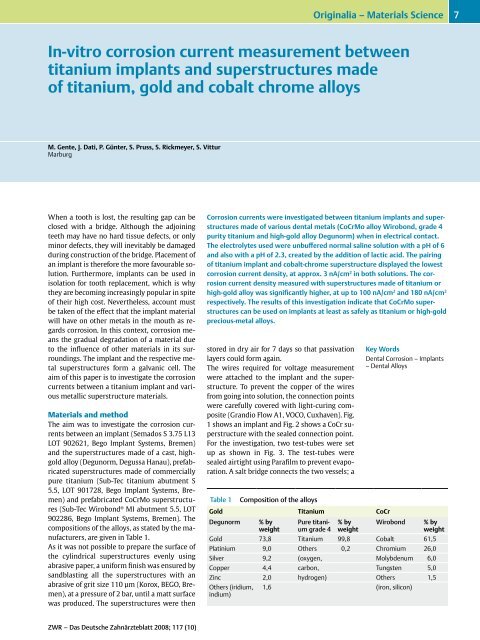
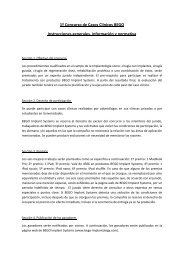
![Folleto del curso [3449823B/pdf] - BEGO](https://img.yumpu.com/49168777/1/184x260/folleto-del-curso-3449823b-pdf-bego.jpg?quality=85)
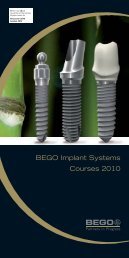
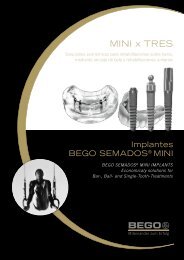
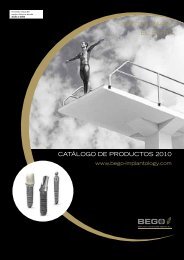
![Folleto del curso [1975602B/pdf] - BEGO](https://img.yumpu.com/35748327/1/190x190/folleto-del-curso-1975602b-pdf-bego.jpg?quality=85)
